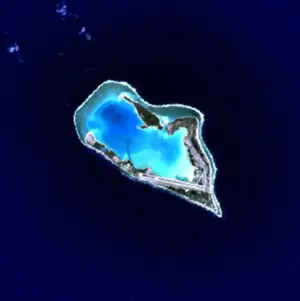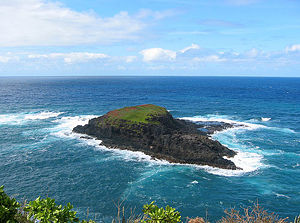Island
An island or isle is any piece of land that is completely surrounded by water, above high tide, and isolated from other significant landmasses. Very small islands such as emergent land features on atolls are called islets. A key or cay is another name for a small island or islet. An island in a river or lake may be called an eyot, IPA [aɪət]. There are two main types of islands: continental islands and oceanic islands. There are also artificial islands. A grouping of geographically and/or geologically related islands is called an archipelago.
The word island comes from Old English ī(e)gland (literally, "watery land"). However, the spelling of the word was modified in the 15th century by association with the etymologically unrelated Old French loanword isle.[1]
Definition

There is no standard of size which distinguishes islands from islets and continents. Any landmass surrounded by water could be considered an island. Under this terminology all the land masses on the planet could be considered islands.
Also, when defining islands as pieces of land that are completely surrounded by water, narrow bodies of water like rivers and canals are generally left out of consideration[citation needed]. For instance, in France the Canal du Midi connects the Garonne river to the Mediterranean Sea, thereby completing a continuous water connection from the Atlantic Ocean to the Mediterranean Sea. So technically, the land mass that includes the Iberian Peninsula and the part of France that is south of the Garonne River and the Canal du Midi is completely surrounded by water. For a completely natural example, the Orinoco River splits into two branches near Tamatama, in Amazonas state, Venezuela. The southern branch flows south and joins the Rio Negro, and then the Amazon. Thus, all of the Guianas (Guyana, Suriname, and French Guiana) and substantial parts of Brazil and Venezuela are surrounded by (river or ocean) water. These instances are not generally considered islands.
This also helps explain why Africa-Eurasia can be seen as one continuous landmass (and thus technically the biggest island): generally the Suez Canal is not seen as something that divides the land mass in two.
On the other hand, an island may still be described as such despite the presence of a land bridge, e.g., Singapore and its causeway or the various Dutch delta Islands, such as IJsselmonde. The retaining of the island description may therefore be to some degree simply due to historical reasons - though the land bridges are often of a different geological nature (for example sand instead of stone), and thus the islands remain islands in a more scientific sense as well.
Types
Continental islands
Continental islands are bodies of land that lie on the continental shelf of a continent. Examples include Greenland and Sable Island off North America; Barbados and Trinidad off South America; Great Britain, Ireland and Sicily off Europe; Sumatra and Java off Asia; and New Guinea and Tasmania off Australia.
A special type of continental island is the microcontinental island, which results when a continent is rifted. Examples are Madagascar off Africa; the Kerguelen Islands; and some of the Seychelles.
Another subtype is an island or bar formed by deposition of sediment where a water current loses some of its carrying capacity. An example is barrier islands, which are accumulations of sand deposited by sea currents on the continental shelf. Another example is islands in river deltas or in large rivers. While some are transitory and may disappear if the volume or speed of the current changes, others are stable and long-lived.
Oceanic islands

Oceanic islands are ones that do not sit on continental shelves. They are volcanic in origin. One type of oceanic island is found in a volcanic island arc. These islands arise from volcanoes where the subduction of one plate under another is occurring. Examples include the Mariana Islands, the Aleutian Islands, Republic of Mauritius and most of Tonga in the Pacific Ocean. Some of the Lesser Antilles and the South Sandwich Islands are the only Atlantic Ocean examples.
Another type of oceanic island occurs where an oceanic rift reaches the surface. There are two examples: Iceland, which is the world's largest volcanic island, and Jan Mayen — both are in the Atlantic.
A third type of oceanic island is formed over volcanic hotspots. A hotspot is more or less stationary relative to the moving tectonic plate above it, so a chain of islands results as the plate drifts. Over long periods of time, this type of island is eventually eroded down and "drowned" by isostatic adjustment, becoming a seamount. Plate movement across a hot-spot produces a line of islands oriented in the direction of the plate movement. An example is the Hawaiian Islands, from Hawaii to Kure, which then extends beneath the sea surface in a more northerly direction as the Emperor Seamounts. Another chain with similar orientation is the Tuamotu Archipelago; its older, northerly trend is the Line Islands. The southernmost chain is the Austral Islands, with its northerly trending part the atolls in the nation of Tuvalu. Tristan da Cunha is an example of a hotspot volcano in the Atlantic Ocean. Another hot spot in the Atlantic is the island of Surtsey, which was formed in 1963.
An atoll is an island formed from a coral reef that has grown on an eroded and submerged volcanic island. The reef rises to the surface of the water and forms a new island. Atolls are typically ring-shaped with a central lagoon. Examples include the Maldives in the Indian Ocean and Line Islands in the Pacific.
Island biogeography
The theory of island biogeography holds that the number of species found on an island (the equilibrium number) is determined by two factors, the effect of distance from the mainland and the effect of island size. These would affect the rate of extinction on the islands and the level of immigration.
Islands closer to the mainland are more likely to receive immigrants from the mainland than those farther away from the mainland. The equilibrium number of an island close to Africa is going to be larger than that of one found in the mid-Atlantic. This is the distance effect. The size effect reflects a long known relationship between island size and species diversity. On smaller islands the chance of extinction is greater than on larger ones. Thus larger islands can hold more species than smaller ones. The play between these two factors can be used to establish how many species an island can hold at equilibrium.
The theory of island biogeography was tested by Wilson and his student Daniel Simberloff in the mangroves off Florida. Small islands of mangroves were surveyed then fumigated with methyl bromide to clear their insect and arthropod communities. The islands were then monitored to study the immigration of species to the islands (the experimental equivalent of the creation of new islands). Within a year the islands had been recolonised, and had reached equilibrium, with islands closer to the mainland having more species, as predicted.
Research conducted at the rainforest research station on Barro Colorado Island has yielded a large number of publications concerning the ecological changes following the formation of islands, such as the local extinction of large predators and the subsequent changes in prey populations.
Factors that Influence Island Communities
- Degree of isolation (distance to nearest neighbor, and mainland)
- Length of isolation (time)
- Size of island (larger area usually facilitates greater diversity)
- Climate (tropical versus arctic, humid versus arid, etc.)
- Location relative to ocean currents (influences nutrient, fish, bird, and seed flow patterns)
- Initial plant and animal composition if previously attached to a larger land mass (e.g., marsupials, primates, etc.)
- The species composition of earliest arrivals (if always isolated)
- Serendipity (the impacts of chance arrivals)
- Human activity
See also
- Desert island
- Insularity
- Island biogeography
- Island country
- Islescape
- Islomania
- List of artificial islands
- List of divided islands
- List of fictional islands
- List of islands
- List of islands by area
- List of islands by name
- List of islands by highest point
- List of islands by population
- Phantom island
- Private island
- Reef
- Skerry
- Small islands
- Tidal island
Notes
ReferencesISBN links support NWE through referral fees
- Print sources
- Larson, Edward J. 2001. Evolution's workshop: God and science on the Galápagos Islands. New York: Basic Books. ISBN 0465038107
- MacArthur, R. H. and Wilson, E. O. 1967. The Theory of Island Biogeography. Princeton, N.J.: Princeton University Press.
- Menard, Henry W. 1986. Islands. Scientific American Library series, no. 17. New York: Scientific American Library. ISBN 0716750171
- Newmark, W. D., A land-bridge island perspective on mammalian extinctions in western North American parks, Nature, 325, 430 - 432 (29 January 1987)
- Nunn, Patrick D. 1994. Oceanic islands. The Natural environment. Oxford, UK: Blackwell. ISBN 0631178112
- Pilkey, Orrin H., and Mary Edna Fraser. 2003. A celebration of the world's Barrier islands. New York: Columbia University Press. ISBN 9780231119702
- Quammen, David. 1997. The Song of the Dodo: Island Biogeography in an Age of Extinctions. Scribner. ISBN 0684827123
- Allan A. Schoenherr, C. Robert Feldmeth, Michael J. Emerson. 2003. Natural History of the Islands of California. University of California Press.
- Online sources
- Graphic Maps. Islands of the World Retrieved April 19, 2008.
- WWF. Oceanic Islands Retrieved April 19, 2008.
- Roberson, Don. May 25, 2007. Oceanic Islands Creagrus. Retrieved April 19, 2008.
- Global Oneness Commitment. Continental Islands Retrieved April 19, 2008.
- Wallace, Alfred R. October 15, 1879. Islands, as Illustrating the Laws of the Geographical Distribution of Animals (S316: 1879/1880) Western Kentucky University. Editor Charles H. Smith. Retrieved April 19, 2008.
- Australian Broadcasting Corporation. Island Life Retrieved April 19, 2008.
External links
- Definition of island from United Nations Convention on the Law of the Sea. Retrieved October 6, 2007.
- Listing of islands from United Nations Island Directory. Retrieved October 6, 2007.
Credits
New World Encyclopedia writers and editors rewrote and completed the Wikipedia article in accordance with New World Encyclopedia standards. This article abides by terms of the Creative Commons CC-by-sa 3.0 License (CC-by-sa), which may be used and disseminated with proper attribution. Credit is due under the terms of this license that can reference both the New World Encyclopedia contributors and the selfless volunteer contributors of the Wikimedia Foundation. To cite this article click here for a list of acceptable citing formats.The history of earlier contributions by wikipedians is accessible to researchers here:
The history of this article since it was imported to New World Encyclopedia:
Note: Some restrictions may apply to use of individual images which are separately licensed.



